“The Immunity Syndrome”
Written by Robert Sabaroff
Directed by Joseph Pevney
Season 2, Episode 19
Production episode 60348
Original air date: January 19, 1968
Stardate: 4307.1
Captain’s log. While en route to Starbase 6 for some desperately needed R&R, Uhura gets a static-filled message from Starbase 6, with only the words “Intrepid” and a set of coordinates. The Intrepid is a ship entirely staffed by Vulcans. While Uhura tries to raise the starbase, Spock becomes overwhelmed—he has telepathically felt the entire crew of the Intrepid die.
As McCoy takes Spock to sickbay, Uhura gets through to the starbase. The Enterprise is ordered to the Gamma VII system, which the Intrepid was investigating. They’ve lost all contact with the Intrepid. Chekov does a long-range scan, only to find that the system—which is inhabited with a thriving star—is completely dead.

McCoy examines Spock and finds nothing wrong. The pain was momentary, but he definitely felt all four hundred Vulcans on the Intrepid die. He returns to duty just as they arrive at Gamma VII. Uhura has lost all contact with the starbase because of the interference, which seems to be coming from an energy reading Spock can’t analyze. It looks like a hole in space where the system (and the Intrepid) should be.
Kirk has Chekov launch a probe, but a loud noise blares through the ship and destroys the probe. But Uhura almost faints, Chekov seems dizzy, and McCoy reports that half the crew has fainted and is suddenly cranky and dizzy and irritable. And the crew was already exhausted going into this mission, that’s why they were headed for R&R.
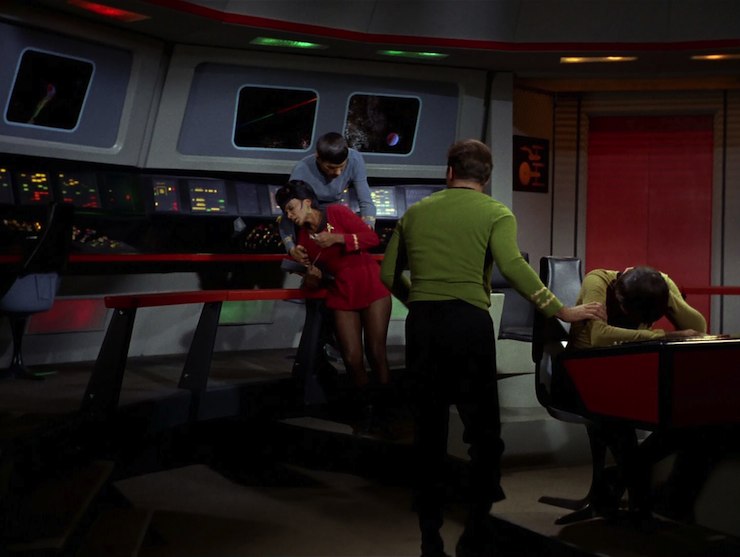
Spock has insufficient data for analysis. It is neither solid, liquid, nor gas, but it did activate the deflectors, so it must be some kind of energy, but not one that the computer recognizes.
Kirk has Kyle approach the zone of darkness, and then the noise comes back. After a few moments, the noise stops—but then the stars disappear. Somehow they have entered the zone of darkness despite not moving. However, they lost five percent of their energy reserves, and Scotty has no idea how or why. McCoy reports that two thirds of the crew is being affected by whatever is making people faint. He and Chapel apply stimulants to the crew.

Opening intership, Kirk gives a pep talk to all personnel, hoping to inspire them to do their jobs despite the exhaustion and stuff. Right after that, just to negate the effect of it, McCoy reports that the energy levels of everyone in the crew is dropping—the whole crew is dying. And that same energy drain is affecting the ship.
The ship is being pulled toward the center of the zone of darkness. Scotty tries to apply reverse thrust, and the ship moves forward. Spock suggests applying forward thrust, and Scotty reluctantly does so—and it works! They’re still moving forward, but more slowly.
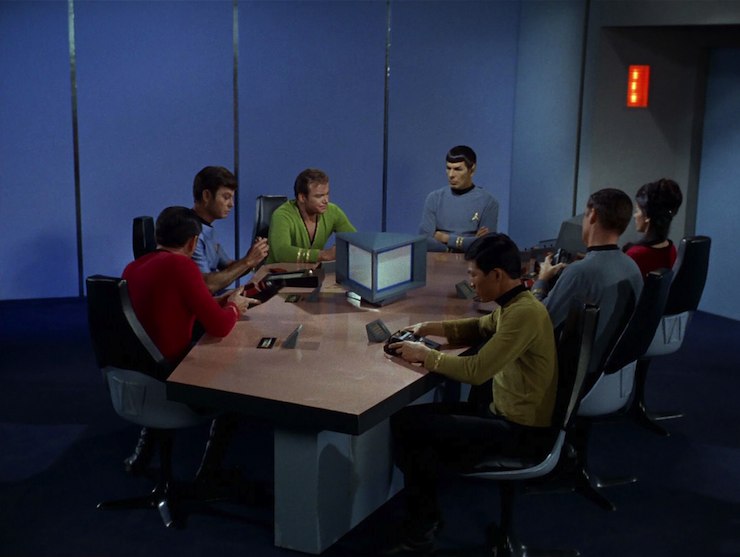
In the briefing room, McCoy reports that the stimulants are helping, but everyone’s still dying. Scotty says that all ship’s functions are working backwards for some reason. Kirk orders Scotty to put all the ship’s power into one big-ass thrust forward in the hopes that it will snap them back out of the zone. Spock also hypothesizes that the zone itself isn’t causing the power drain, but something else inside it.
Spock is concerned that the Intrepid would have done all this stuff, too, but Kirk points out that the sheer illogic of the situation might have vexed the Vulcan crew.
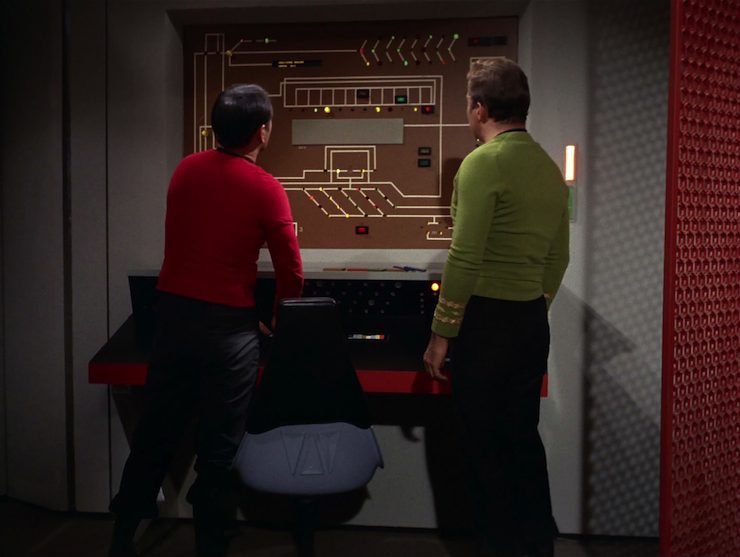
Scotty channels all the power into the forward burst, but all it does is allow them to maintain position. At this point, they’ve got two hours of power left.
And then the heart of the zone of darkness reveals itself as it approaches. It looks like a giant space amoeba, and Spock confirms that it’s the source of the energy drain. Chekov launches another probe. Spock reports that it is alive, and it is drawing the Enterprise to its death the same way it drew the Intrepid.

McCoy verifies that it is an amoeba—it’s an even simpler life form than the more normal microscopic amoeba they’re used to. They need more information, and the probes can only tell them so much, and they dare not take the ship closer to the amoeba and risk losing power faster.
Both Spock and McCoy recommend taking a shuttlecraft to probe the amoeba and find its vulnerable spots. They also both volunteer to be the pilot, even though it may be a suicide mission. McCoy has already done the preliminary research, and he’s the biology expert; Spock believes he can assess the data more objectively and rationally. Kirk must choose one of them to take on the mission.

It’s a difficult, impossible choice, as he must condemn one of his two closest friends to death. Both are qualified, but ultimately he gives it to Spock. McCoy equips the shuttle with everything he’ll need.
Spock penetrates the amoeba’s structure, and determines that it has stored enough energy for reproduction. Spock reduces life support to bare minimum in the hopes of having enough power to get back. Uhura picks up a weak signal from Spock, saying that the amoeba can be destroyed from the inside only, as the outer membrane protects it.
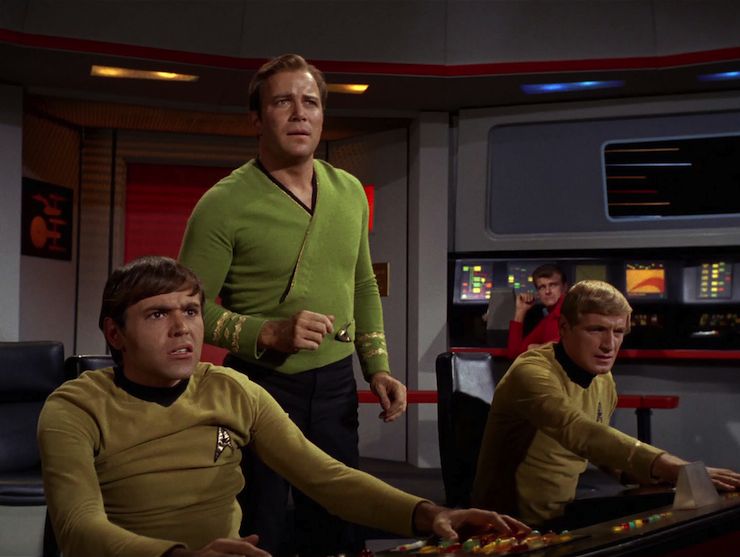
Kirk orders Scotty to cut the thrust, and divert all power to shields. He wants the ship to be drawn inside so they can act as an antibody to this amoeba that appears to be a galactic virus. They have to stop it before it reproduces. Since everything seems to work in reverse, Kirk orders Scotty to prepare a magnetic bottle with antimatter, which is the only form of energy this thing is likely not to eat.
After recording a log recommending commendations to McCoy, Scotty, Uhura, Kyle, and Chekov, and a posthumous commendation for Spock, Kirk orders the antimatter bomb to be dropped in the nucleus. It’s on a seven-minute delayed detonation, and Chekov says they’re just over six minutes out.
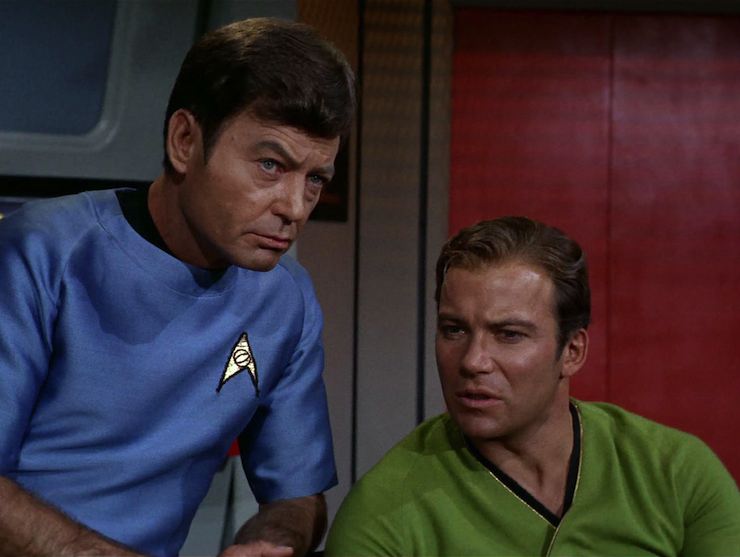
They detect Spock’s shuttle, and despite both Spock and Scotty recommending against it, Kirk orders a tractor beam on the shuttle. Power goes dead, but inertia carries them out of the amoeba’s membrane. The explosion destroys the amoeba, and power is restored to both the Enterprise and the shuttlecraft.
Once the shuttlecraft is back on board, Kirk has Chekov set a course for Starbase 6 for a now really really desperately needed R&R.
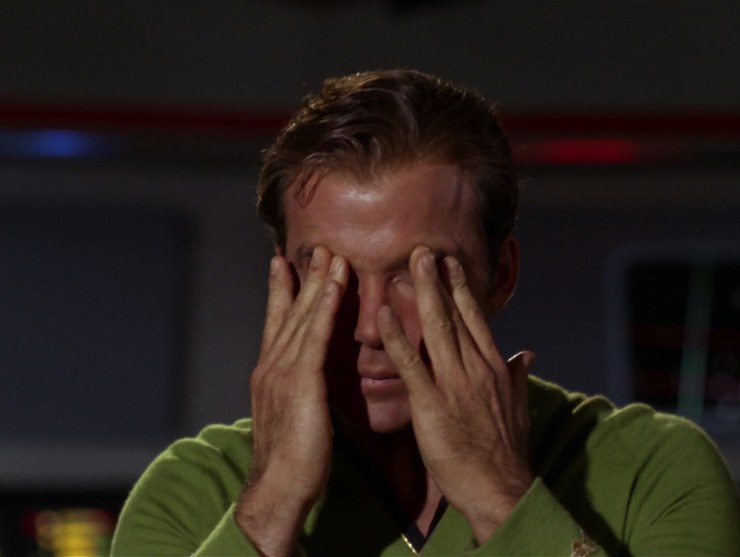
Can’t we just reverse the polarity? The space amoeba is eleven thousand miles long, width varying from two to three thousand miles, its outer layer is studded with space debris and waste, while the interior consists of protoplasm. That’s a big Twinkie….
Fascinating. Though Vulcans are touch telepaths, the death of four hundred can be felt over light-years. Spock also has a rare moment of sentiment, recording a personal log that commends the crew of the Enterprise, calling them the finest crew in the fleet.
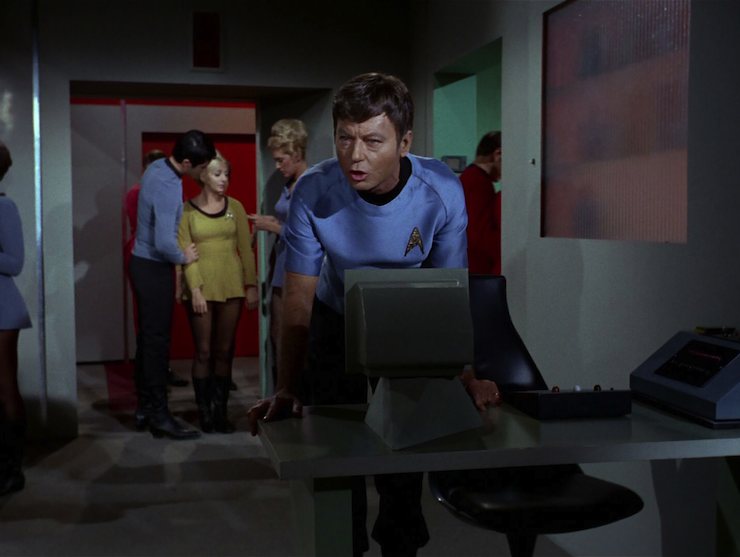
I’m a doctor not an escalator. McCoy is eager to be the one to investigate the amoeba as it’s a biological discovery of great value. He’s very cranky about the fact that Spock gets to go instead.
Hailing frequencies open. Uhura has to constantly fight her own dizziness and the interference put out by the amoeba in order to get communications to work.
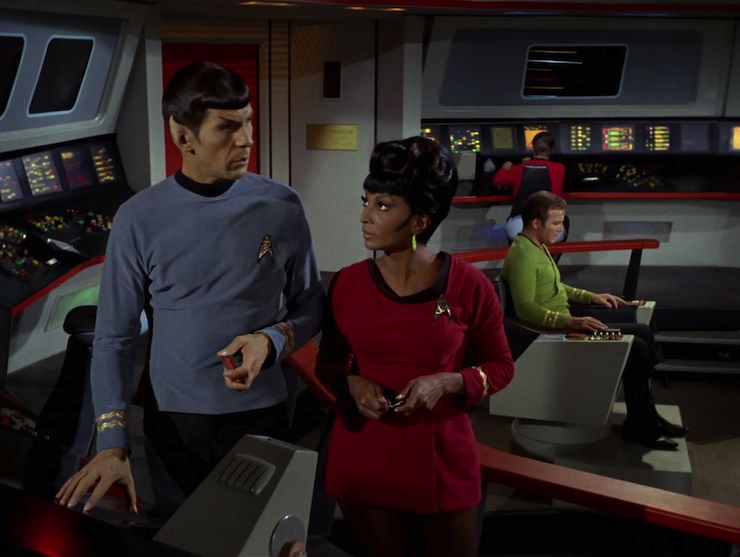
I cannot change the laws of physics! Scotty is his usual can-do self, constantly telling Kirk what a bad idea things are and how badly they can go wrong and such.
It’s a Russian invention. When they penetrate the amoeba, Chekov triumphantly cries, “We’re through, sir!” and Kirk snottily tells him that they’re all aware of that. Give the kid a break, Jim, he was excited!
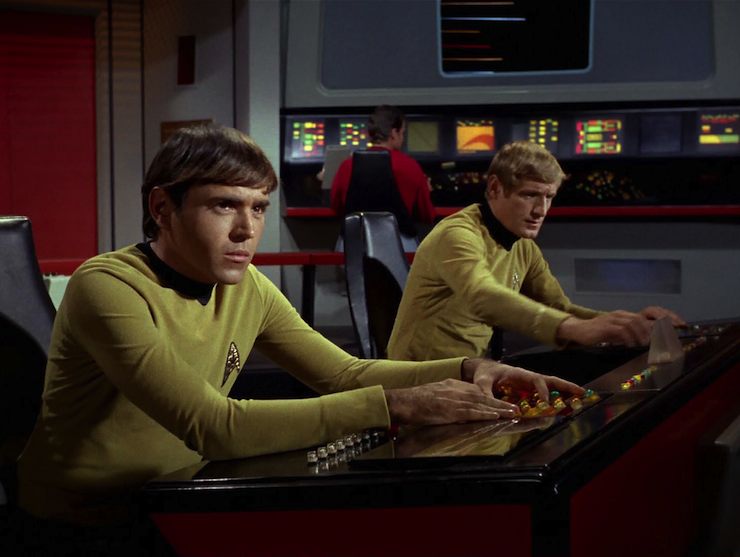
Ahead warp one, aye. Kyle gets to be the helmsman this time ’round. He wears a gold uniform so the stock footage of the navigation console with Chekov visible on the right and the right arm of the helmsman visible on the left would still work.
No sex, please, we’re Starfleet. Before the shuttle enters the amoeba’s insides, Spock warns, “The area of penetration will no doubt be sensitive.” Wah-HEY!
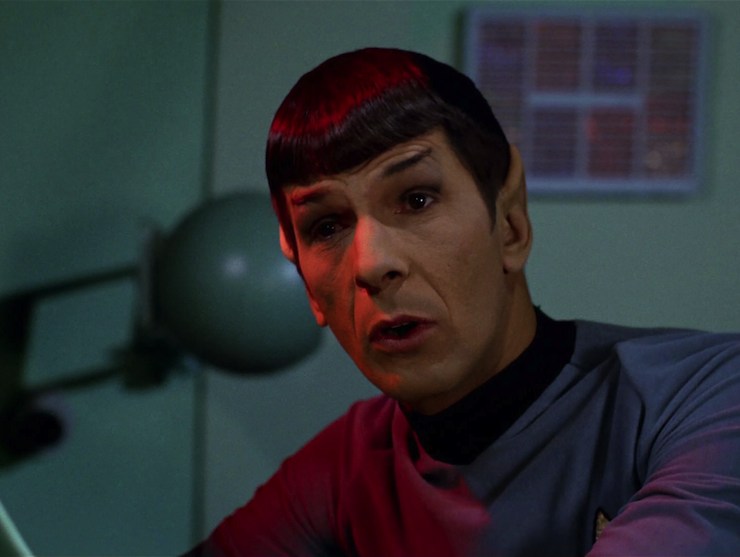
Channel open. “Captain, I recommend you abandon the attempt. Do not risk the ship further on my behalf.”
“Shut up, Spock, we’re rescuing you!”
“Why thank you—Captain McCoy.”
Spock being all heroic and self-sacrificing and stuff, McCoy snarking him off, and Spock snarking right back.
Welcome aboard. No major guest stars this time ’round, just recurring regulars James Doohan, Nichelle Nichols, Majel Barrett, Walter Koenig, and John Winston.
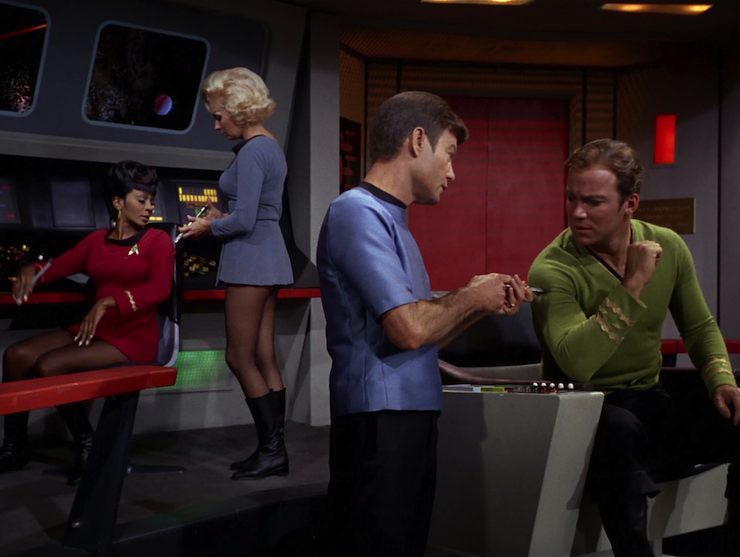
Trivial matters: This is the last time on the series that we see Kirk’s green tunic, the interior of a shuttlecraft, and an episode directed by Joseph Pevney. Pevney was brought in by Gene L. Coon to direct “Arena,” and he became one of the show’s go-to directors (he’s tied with Marc Daniels for most episodes directed). However, Pevney felt the on-set behavior of the actors went south with Coon’s departure, and so he did not come back after this one.
This is Robert Sabaroff’s only script for the original series, but he would be involved in writing two first-season TNG episodes, “Home Soil” and “Conspiracy.”
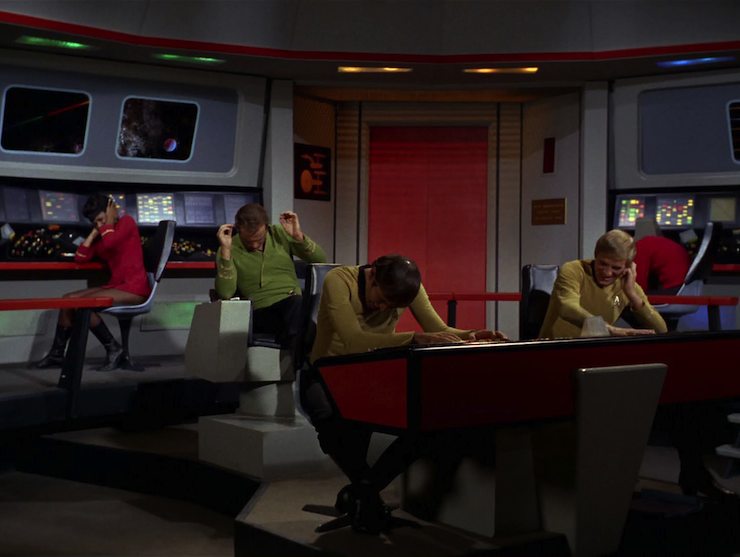
There are a lot of similarities between this episode and the TNG episode “Where Silence Has Lease,” particularly in its first half with holes in space and such.
To boldly go. “Don’t be so smart, Spock, you botched the acetylcholine test!” A surprisingly effective “bottle show,” with no guest stars, no great revelations, but a tense situation that echoes both “The Corbomite Manuever” and “Obsession,” without feeling too terribly similar to either. Although it’s probably best that this didn’t air back to back with “Obsession” originally, as they are both similar enough (non-sentient dangerous creature that is stopped by antimatter). This one comes across far better because the captain doesn’t act like an idiot.
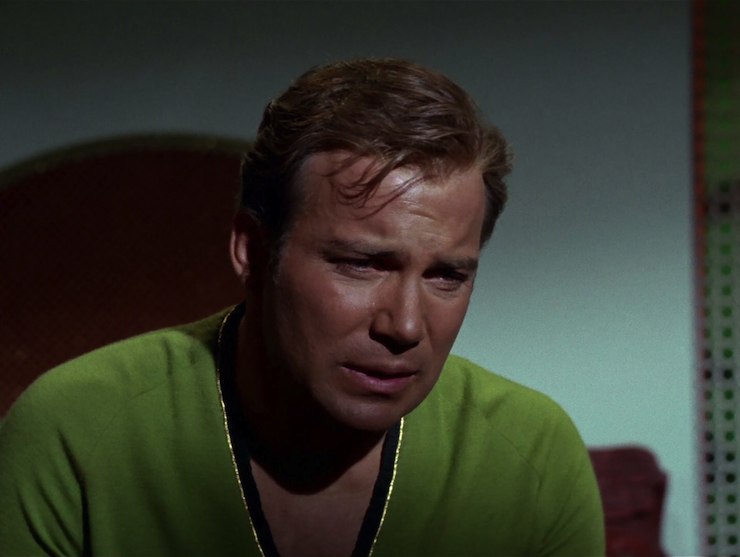
This story does reveal a pattern in this second season, though, and it’s not a great one. The first season was impressive because there were very few true monsters. The evil destroying lizards of “Arena” turned out to be a proud species of people known as the Gorn who were just defending themselves. The evil acid-spewing creature that killed the miners in “The Devil in the Dark” turned out to be a mother protecting her young. The big-ass ship with the ugly guy running that endangered the ship in “The Corbomite Maneuver” turned out to be a very weird first contact. Even the salt vampire of “The Man Trap” had an element of tragedy about it as the last of its kind. Trelane was just a kid playing with his toys, Charlie was just a kid who wanted to be loved, Kodos/Karidian was a monster and now is an old man trying to put his past behind him, the planet isn’t trying to kill them but is rather an amusement park, and so on.
This season, though, has had less of the redemptive and compassionate aspect. We still have it in places like “Friday’s Child” and especially “Metamorphosis.” But the evil energy creature who kills people in “Wolf in the Fold” is really an evil energy creature who kills people. The big thing that kills planets in “The Doomsday Machine” is really a big thing that kills planets. The cloud creature that sucks out people’s blood in “Obsession” is really a cloud creature that sucks out people’s blood. And the big-ass space amoeba that sucks energy here is just a big-ass space amoeba that sucks energy. And in all four cases, the Enterprise‘s mission is to destroy it, which is significantly less interesting than learning about it.
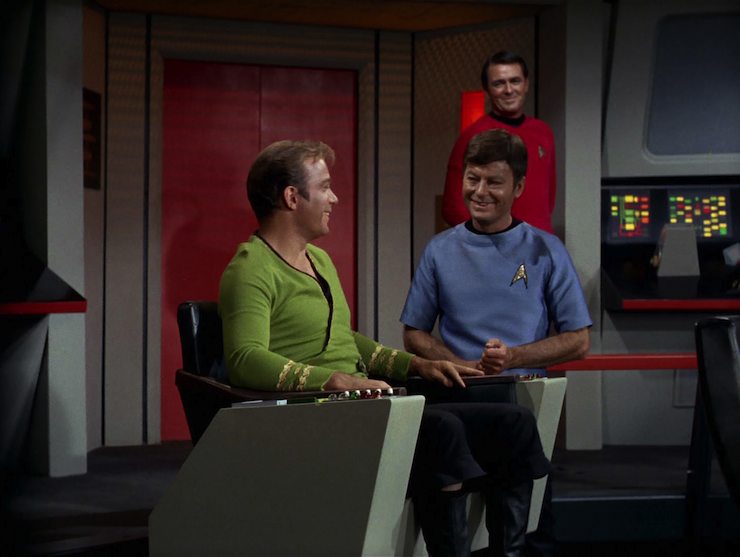
It’s only disappointing insofar as it reduces the bad guys to just monsters, moving away from the humanistic elements that made Star Trek stand out in the first place.
Having said all that, it works here, especially since the amoeba is just that—the simplest possible life form, albeit with a pituitary problem. There’s no real chance of it being intelligent, and it starts with destroying a starship and an inhabited solar system. It’s definitely something that needs to be stopped before it can reproduce.
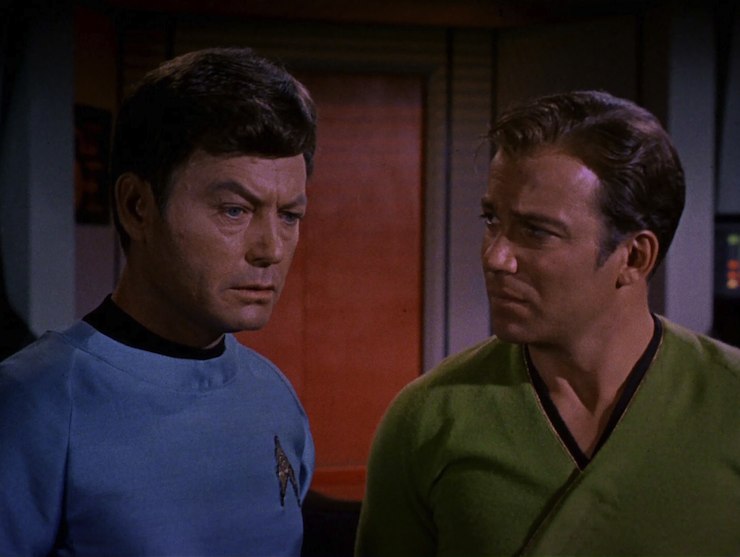
Several elements make this episode work beautifully. For starters, the crew’s exhaustion adds to the tension—both Kirk’s no-please-we-want-to-go-on-shore-leave-we’re-pooped pleading at the top of the episode combined with the amoeba draining their energy adds a miasma of fatigue to the proceedings. Notably, though, at no point does it compromise anyone’s ability to do their job. Twice the crew is referred to as the finest crew in the fleet, and no better evidence of that can be provided than the fact that they all stay at their posts and do their jobs superlatively even with all this crap being thrown at them.
And then there’s the Kirk-Spock-McCoy triad, which is at its finest here. McCoy’s enthusiasm for going on the shuttle mission and his resentment at Spock is beautifully played by DeForest Kelley, while Leonard Nimoy’s reserved snottiness is pretty much on overdrive. But you also see the underlying respect and affection they both have for each other (something less in evidence in places like “Bread and Circuses” and “The Gamesters of Triskelion,” which both could’ve used it).
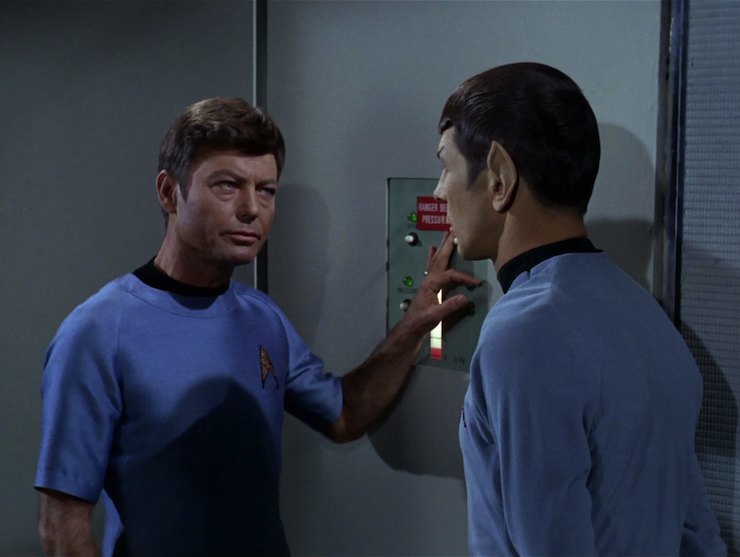
Finally, William Shatner does a really good job as the leader of all this. His agonizing over the decision of who to send is palpable, but his choice is really the only right one, as the mission truly does require someone who can remain calm and who has greater physical stamina.
Warp factor rating: 7
Next week: “A Piece of the Action”
Keith R.A. DeCandido just finished writing The Warriors Three: Godhood’s End, the third book in his Marvel’s Tales of Asgard trilogy. The first book, Thor: Dueling with Giants is available as an eBook, with the print book due this month; the second book, Sif: Even Dragons Have Their Endings, is available for preorder now.










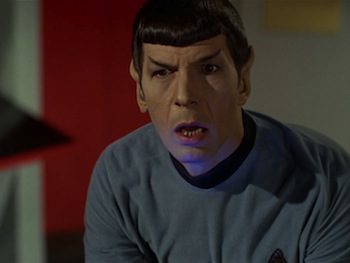

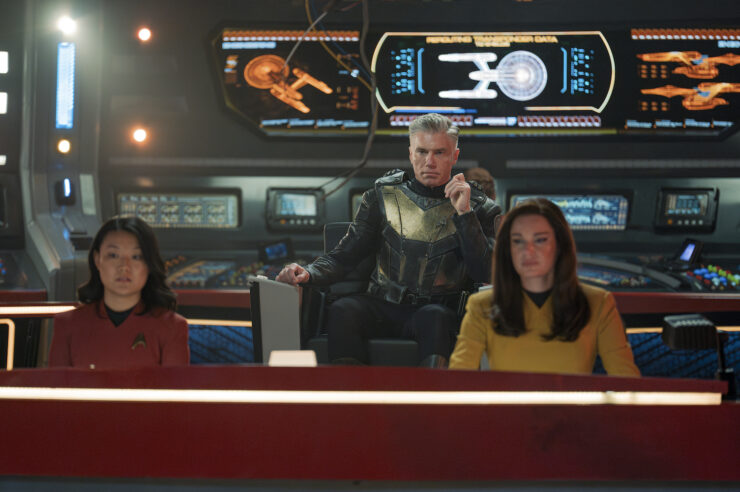
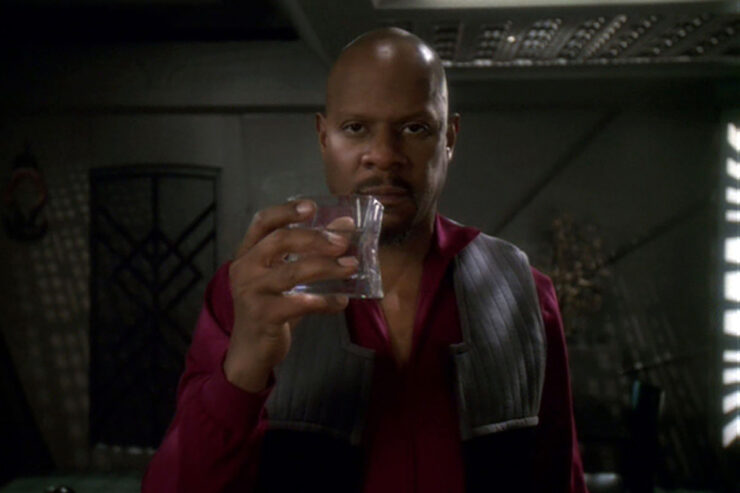

I wasn’t sure what you’d make of this one, Keith. I’ve always liked the episode for its drama and tension and character interplay, and the reuse of Sol Kaplan’s “Doomsday Machine” score adds a lot of intensity and grandeur to the proceedings, but conceptually, it’s really, really dumb. A giant amoeba in space? A zone that inexplicably drains energy and makes everything work backward? And the logic behind the antimatter thing is silly. Antimatter will destroy anything except other antimatter. Given that the ship’s armaments routinely include photon torpedoes — i.e. torpedoes with antimatter warheads — it’s kind of a no-brainer to use antimatter to destroy things, but it’s treated here as some big revelation. And Kirk’s logic doesn’t work anyway — if everything’s inverted, wouldn’t it follow that antimatter wouldn’t hurt it?
The implication that Starfleet was organized into segregated, single-race crews was a bit troubling too, though it’s not out of character for the Vulcans to have trouble playing well with others. It’s always been assumed that the Intrepid was a Constitution-class ship, but ever since Enterprise, I’ve wondered if it might actually have been a ringship of the type the Vulcans were using in the 22nd century (albeit more advanced, of course).
You mentioned the similarity to “Where Silence Has Lease.” It always bugged me in that episode that, upon seeing a zone of darkness that appeared almost exactly like the one from “The Immunity Syndrome,” Data said definitively, “There is no record of any Federation vessel encountering anything remotely like this.” That’s a pretty major continuity glitch. For a while, I wondered if maybe Roddenberry had inserted that line deliberately in order to implicitly decanonize “The Immunity Syndrome” — I gather that at that stage in his life, he’d come to regret a lot about TOS and wanted to retcon out the parts he found silly or embarrassing. But my more recent understanding is that his ill health had forced him to withdraw to more of an honorary consultant position by the second season of TNG, so he wouldn’t have been actively rewriting the scripts anymore. So maybe it really was just a continuity error, although if so, it’s surprisingly on-the-nose.
One thing I remember about this episode is that it’s one of the first Trek episodes I ever saw in color, when my family was on vacation and I got to see it on the hotel’s color TV. It must’ve been around 1979-80, because I also saw a second-season Jason of Star Command episode in color for the first time and was amazed to learn that Commander Stone had blue skin. Anyway, “The Immunity Syndrome” in color was a revelation. It was quite spectacular to behold.
Another childhood memory: A local independent station used to show Star Trek reruns and Space: 1999 episodes back-to-back, and one night, it showed Star Trek: “The Immunity Syndrome” followed by Space: 1999: “The Immunity Syndrome.” It’s weird that two different shows would use the same, rather unusual title. I mean, it’s not the kind of common word or phrase you’d expect to see as a title on multiple shows, like “The Enemy Within” or “Mirror, Mirror” or “Obsession,” say.
1/Christopher – I don’t know that one has to infer from the single example of the Intrepid that “Starfleet was organized into segregated, single-race crews.” I never did, at least. (I do agree with you, though, that after Star Trek: Enterprise, a single-race ship of Vulcans makes some sense). What does strike me now, though, is how strange it is that a ship “manned by Vulcans” (McCoy doesn’t say “entirely manned by Vulcans,” though I grant that’s the plain sense of his words… still, maybe its a majority Vulcan crew…) would be christened a word in any language other than Vulcan. Maybe that was the English translation. (Are we using “Federation Standard” at this point in Trek? Or am I just imagining there is a Trek equivalent to Star Wars’ “Basic”?)
There might be logistical arguments for single-race ships. After all, doesn’t Spock complain about the temperature aboard Enterprise sometimes? (Or is that just in novels?) I know Roddenberry’s TMP novelization has Spock reflecting about how noisy the Enterprise is (still a majority human crew at that point, despite all the cool aliens the production team invented). If Starfleet were segregating starship crews as a matter of course (and I don’t think they were), surely there would be good, non-prejudicial, non-malevolent reasons for it. (No, I would not extend this reasoning to real-life examples of segregation – I’m just sticking strictly in-universe, thinking sometimes it might be beyond reasonable accomodation to have interspecies crews. Look at how the Deltans still have to take “oaths of celibacy” to serve in Starfleet by TMP – well, at least Ilia did.)
Very good write-up, Keith, and a very good point about how TOS was devolving into monster o’ the week. I’d never noticed before, watching the episodes all out of any semblance of order in syndication as a kid.
I’ve always enjoyed the amoeba’s visual effects, both the original and the redone HD version. I assume this looked pretty groundbreaking back in 1967/68, even though it would quickly become dated thanks to the eventual release of 2001: A Space Odyssey that same year, setting new benchmarks for quality visual effects.
Immunity Syndrome is one of my favorite season 2 entries, for sure. Great character work. Great use of tension and surprisingly well paced.
My only quibble has to do with Spock’s final log, when he goes a little bit over the top in his praisal of the Enterprise’s crew. Too much for Vulcan standards. It feels written rather than natural.
I don’t really buy the explanation behind Pevney’s departure. It’s the same excuse used by Joseph Scanlan on TNG. The cast is too out of control. Why would Gene Coon leaving would affect the cast’s mood? I’d understand if it were Roddenberry quitting (as it eventually happened), but not Coon. Personally, I feel this has to do with Paramount buying Desilu and deciding to save money by cutting a day’s worth of shooting for each episode. That would be credible grounds for a director to quit the show, and I believe that was the reason Marc Daniels left the following season.
As for the trend of this season boiling down to simplifying bad guys, I can see Keith’s point. I see two reasons for this:
1. Coon attempting to back away from Roddenberry’s morality play approach and more towards brainless action-adventure.
2. They were simply running out of ideas.
@1/Christopher: I’m not so sure I agree with the decanonizing assumption. If Roddenberry felt embarassed by the space amoeba concept, he wouldn’t have hired Robert Sabaroff to pitch TNG stories. Or would he?
I prefer to assume that they simply forgot about Immunity Syndrome when writing Where Silence has Lease. Remember they made that episode in the wake of a major writer’s strike. I can see them rushing the script without proofreading. Nobody’s perfect under pressure.
Totally agree about Kirk in this episode vs Obsession. Here, the amoeba is the invader and there’s no indication of intelligence. It’s still unfortunate that we don’t get to learn more about where it came from and what it was doing but it was apparent;y just too alien to coexist with life in our universe. It’s nice to see Kirk agonizing over the possibility of being the one responsible for the death of someone, particularly a friend. He was much more cavalier about the Thetans in Obsession. Once again, it does show that Kirk rends to take things more seriously when he’s got a personal stake in things.
All in all, a nice episode for the character moments although the science is, once again, best ignored. A particularly nice bit was seeing Kyle on the bridge and him getting a shout out from Kirk to boot. It would have been nice if we’d gotten more moments like this for the recurring minor characters. Sadly, the big three tend to dominate even more in the third season.
Having ships with a majority of the crew as one race makes a lot of sense. When we had Sarak need medical attention in Journey to Babel, McCot wasn’t even sure he could do the surgery, wasn’t sure how the drug would work on a Vulcan etc. This was later rectified with the appearance of M’Benga but you’d think that your medical staff would be able to take care of the races that are serving on the ship. Now multiply that by the number of aliens we saw in TMP, some of whom don’t appear to be mammalian or even capable of breathing the same atmosphere and the problem is even more extreme. Yes, it would make a nice statement about people of different species getting along together but I’m not sure I’d be comfortable serving on a ship without adequate medical care for years at a time.
@2/Mike: Another reason for Vulcan-only ships could be that it allows them to keep Pon Farr secret.
Why is the episode called “The Immunity Syndrome”?
@3/Eduardo: I’m sceptical of your first reason, because many of the really good morality plays were written by Coon. Maybe they could afford better writers in the first season?
@2/Mike: Of course I wasn’t saying one had to infer segregation — simply that one could. An implication can be disquieting without being an unambiguous fact.
@3/Eduardo: I wouldn’t say TOS’s effects “quickly became dated.” Like I said, when I saw this episode in color for the first time in 1979-80, it still looked terrific to me, even though that was after not only 2001 but Star Wars and ST:TMP.
That makes no sense. A writer is not a story. You can be unhappy with a single idea without blacklisting its creator over it. Heck, most writers are unhappy with plenty of their own past ideas and try to retcon them away in their later work — cf. George Lucas and the Star Wars special editions, or David Gerrold’s rewrites of several of his older novels. Or, for that matter, Roddenberry himself retconning the Klingons’ appearance in TMP. Everybody who actually writes for a living will understand implicitly that even good writers have bad ideas from time to time, that failing and learning from it is an integral part of the creative process.
@5/Jana: I think the title is in reference to McCoy’s musing about the ship and crew functioning as “antibodies of our own galaxy, attacking an invading germ.” In other words, they’re functioning as the immune system of the galaxy.
The premise of the Space: 1999 episode of the same name involved a whole planet’s environment attacking the visiting humans and their ships as if fighting off an infection — although, in a very Trekkish twist, it turned out to be the work of a godlike but naive energy being that didn’t understand the harm it was causing until the hero talked to it and helped it understand.
@6/JanaJansen: I’m not denying Coon’s ability to write superb and intelligent episodes like Arena and Metamorphosis. He can definitely create thoughtful shows. But at that point, he was still learning to play on Roddenberry’s universe. By season 2, however, you can see a gradual shift towards comedy or pure action-adventure. Since Coon (and also Lucas) is responsible for every script, I’d argue it’s an intentional storytelling shift on his part.
@7: Indeed, I was stretching a bit by mixing story and writer this much.
Regardless, I still don’t think Roddenberry would deliberately insert a line in a random episode to decanonize another episode like this. And, as you’ve pointed out, he was probably not even that involved by this point. I stand by the writers’ strike situation as being the likely reason behind any season 2 production mistakes.
Quoth Eduardo: “I don’t really buy the explanation behind Pevney’s departure. It’s the same excuse used by Joseph Scanlan on TNG. The cast is too out of control. Why would Gene Coon leaving would affect the cast’s mood? I’d understand if it were Roddenberry quitting (as it eventually happened), but not Coon. Personally, I feel this has to do with Paramount buying Desilu and deciding to save money by cutting a day’s worth of shooting for each episode. That would be credible grounds for a director to quit the show, and I believe that was the reason Marc Daniels left the following season.”
I doubt that cutting shooting time would’ve been a factor for Pevney, since the whole reason why he was so prolific was because he got the shoots done faster than anyone else. But he was also specifically hired by Coon, so it’s possible that Lucas didn’t want to use him because he was Coon’s dude, and Pevney told the bickering-actors story because of sour grapes. On the other hand, it’s not like Pevney was the only one who has discussed the bickering actors of Star Trek…….
—Keith R.A. DeCandido
@1,
IIRC, the Star Trek Technical Manual lists the Intrepid as one of the 12 original Constitution class starships. (yes, its supposedly not canon, but it sure shows up a lot) So not a Vulcan ring-ship.
@9/Eduardo: Sure — as I said, I’ve already abandoned the idea that it was deliberate, so I certainly don’t need to be talked out of it. But it is quite a coincidence that, on the one hand, the “area of blackness” in “Where Silence Has Lease” was so uncannily similar to the “zone of darkness” in “The Immunity Syndrome,” having a similar shape and attributes (referring to its original, squarer shape, not the TOS-R version shown above where it’s given much the same shape as the amoeba), and yet at the same time, there was such specific dialogue from Data explicitly ruling out its similarity to anything any starship had encountered before. That’s downright weird, which is why it’s stood out in my mind for so long.
By the way, I’m pretty sure the same animated matte outline they used to create the zone of darkness here was also used to create the title entities in “The Lights of Zetar” in season 3. It’s hard to tell from stills, since it was moving and changing, but the Zone and the Lights have pretty much the same shape.
@11/Ragnar: Yes, as I said already, the Intrepid has always been assumed to be a Connie. Of course I know that. What I’m saying is that the new information we got from Enterprise about Vulcan ship designs introduces a new possibility that wouldn’t have occurred to fans back in the ’70s when the Star Fleet Technical Manual and other references like it were being made. So I know what it assumed, but I’m saying we don’t have to be limited to that decades-old assumption.
This is one of the better done space anomaly episodes in terms of the crew dynamics and pacing, and one of the worst in terms of science. (The extremely similar one with Captain Decker and the planet-eating whatsit is just about as bad at science.)
… It also raises a lot of questions about how Vulcan telepathy actually works that are stomped all over by the new movies, but a lot of things are stomped on by the reboot. *Sigh.*
In regards to the Vulcan ship… it could be inferred that like Enterprise is registered out of Earth and may have been built (in orbit) there, and that a “Vulcan” ship would be one built near and registered out of Vulcan. (And that possibly the vulcans in starfleet may have gravitated towards scientific ships…)
Or it could just be an artifact of the show still assuming that the planets of the federation would largely have their own ships and that “starfleet” was more of a collective term than a singular organization. On the other hand, it has always bothered me that later shows have made Earth the center of the Federation. There’s probably some logistical reasons in-universe for it to make sense (Vulcan being hot and isolated, Andoria being frigid…) but by and large it functions as an excuse for having non-human officers be rare and for the writers to visit Earth a lot. Or for the reboot writers to pretend there are no consequences for blowing up Vulcan beyond “lots of people died.”
@1: the Watsonian explanation for a lack of recording of the incident in TNG is that either the Enterprise recorded it poorly, the recording was lost or not transmitted to the new Enterprise’s library, or the nanobots accidentally ate it that one time. ;)
Wah-HEY! indeed.
I remember being bored with this episode last time I watched it. Maybe I was just as tired as the crew, so I should probably give it another chance. The simple monster thing is a bit tiresome at this point, but I do enjoy the sheer lunacy of a big ass space amoeba. Like a Star Trek script written by Jonathan Swift. Very Gulliver.
Also, a telepathic character sensing mega death across lightyears? Seems like I saw that used in a later movie…
I’ve seen multiple artist interpretations of Constitution type vessels with a Vulcan-style warp ring in place of the standard nacelles, in both TOS and TMP Refit dress. I’ve always assumed that Vulcan Starfleet vessels were of this type and had some accommodations specific to Vulcans such as higher gravity, higher temperature, lower humidity, brighter and warmer-spectrum lighting, and medical and mess facilities equipped and staffed by and for Vulcans. And of course, the differences in the Engineering section due to the different warp engine configuration. Other than those things, they would be standard Starfleet vessels and could be converted back and forth from standard Human to Vulcan spec with a few weeks in Stardock.
There’s no reason they wouldn’t have standard armaments even, as Vulcans are fully capable of understanding when force is a logical necessity. Vulcans as a whole aren’t complete pacifists, though some of them are, they just are very strict about violence being a true last resort to be avoided at all possible. Those unable to handle that possibility would be kept from serving aboard armed vessels, sticking to home-built pure science vessels.
@13. Quill – Yeah, Spock can sense the deaths of 300 Vulcans across light years but JJ-Spock has no such reaction when billions are killed just a couple of hundred miles away. Of course, Spock is the character that’s most changed in the new reality. Kirk just over emphasizes the bad bot image that he had, but Spock seems like an entirely different person despite being the one who looks most like his original counterpart. It’s almost like watching Nimoy if he took an entirely different path than he did on TOS. That’s Nimoy, the actor as opposed to his character. Nimoy came up with a lot of how Vulcans were portrayed since he had no reference to work with other than a couple of paragraphs in the show;s bible. The fact that they’re supposed to be the same character doesn’t seem to work in this case. As has been said, When Spock is your most emotional character, you’re doing it wrong. Of course, Quinto isn’t helped out at all by the scripts of the two movies.
“It’s as if hundreds of voices suddenly cried out in terror and were suddenly silenced. I fear a plot point has happened.”
@13/Quill: New Trek productions have been “stomping on” fan assumptions for decades. When TNG came along, it overwrote huge amounts of fan lore and tie-in fiction, and many fans were outraged and resented it for overwriting their preconceptions. That’s just the way any ongoing series works. Fans speculate things, then new stories are told that establish something different. Because of course they do.
And the nanobot episode was at the start of the next season.
@15/Han Rasmussen: I’d like to see some of that fan art. As it happens, I just came across an image of a 24th-century-style Starfleet ringship on Facebook earlier today, but I’d be interested to see a 23rd-century version.
Even in DS9 we have an all-Vulcan crewed Starfleet vessel in the baseball episode, which seems much, much weirder in that time period than in TOS.
Quill: Huh? What scientific issues were there with “The Doomsday Machine”? (Which, BTW, was written by well-regarded science fiction author Norman Spinrad…..)
—Keith R.A. DeCandido
I love this one, even if the science is a bit icky. It was entertaining to watch crew interaction, especially Spock and McCoy – their relationsip is the most inconsistently written thing in TOS, and in this episode it is done perfectly. Loved McCoy’s “you botched the test” in the end, just the best way to say “we’ve made it, we’re alright, everything is back to normal”.
The name of the episode doesn’t make much sense to me though. I get what they wanted it to mean but it just sounds wrong. But maybe it’s because my English isn’t good enough.
@20/krad: There are some issues with “The Doomsday Machine,” though not as bad as some. The main one that I think I mentioned in the review thread for that one: How can something only a few kilometers long eat entire planets? The scale just doesn’t make sense. And breaking a whole planet apart would take a far greater amount of energy than most sci-fi tends to assume — basically the entire energy output of the Sun for a week to disintegrate an Earth-sized planet. A mere antiproton beam couldn’t do nearly that much damage. Plus, getting a bit more nitpicky, a “pure antiproton” beam would dissipate pretty quickly due to mutual repulsion between its like-charged particles.
I’ve always felt the planet killer from Doomsday Machine to be rather small. Not much bigger than the Enterprise.
In terms of scale, I find the V’Ger cloud and vessel to be far more credible in terms of conveying the necessary sheer power to consume a whole planet.
@23/Eduardo: Except the V’Ger vessel is actually only about the size of Maui, so it’s still tiny compared to a whole planet. Human beings are very bad at comprehending just how huge a planet is, even though there’s one right here underneath us. We just can’t see enough of it at any one time to have a good sense of its scale.
What could work is if the planet-killer vessel or entity were built around a black hole. It could be only a few kilometers across, but able to devour a whole planet in time. Although you’d pretty much have to let it bounce around inside the planet, hollowing it out from within until there was just debris left, which might take a few weeks, depending on the size of the hole. (David Brin’s novel Earth depicts a microscopic black hole getting loose inside the Earth and needing a couple of years to devour it; I’m assuming a somewhat larger hole.) Also, a black hole’s so massive that moving it around would be quite difficult.
@24/Christopher: Starkiller Base should have employed a black hole system like that. Would have been more original than having it draw solar energy to power up a superlaser.
Speaking of Force Awakens, the scale issue reminds me of a well designed shot from Return of the Jedi, where despite its sheer size the Death Star is still noticeably tiny compared to the forest moon of Endor (the dropping out of hyperspace sequence, specifically). And I feel they failed to get that same sense of scale with Starkiller Base. Didn’t really feel bigger than the Death Stars.
@25 — I recently learned that Death Star II was much larger than Death Star I. This was a surprise to me. Since we never saw them side by side or with a common frame of reference, I always assumed they were twins.
I had the same impression of Starkiller as you. If it had had a moon of its own or some type of Dyson sphere… uh, scaffolding, hehe, that may have helped sell the larger size. I really hope that’s the last (new) superweapon we see in Star Wars for a long time. But I digress.
@24. ChristopherLBennett – Except we now know that that is not how black holes in the Trek universe work. Vulcan was swallowed pretty quickly by a black hole that used a fraction of the red matter. And another small part somehow managed to reverse the effects of a supernove (hypernove? giganova? What do you call a supernova that threatens a galaxy?)
Trek science has only the most passing similarity to ours. And that’s OK because Trek is not Nova (the PBS series, not the kablooie thing). Trek is for telling little 45 minute morality plays or action/adventure stories. Noticing every time Trek got science wrong would pretty much be a deal break for me since I’d spend half the show yelling at my TV.’
I love this ep. One of the better Star Treks and shows like this are why I love Star Trek. I feel the same way about Obsession (sorry Keith!) but wasn’t able to comment back when you posted that.
More of this and less of crap like The Gamesters of Triskelion, in spite of their Quatloos line.
Did George Takei have another commitment the week this episode was filmed?
I was never able to get past the idea of the “giant space amoeba” to enjoy the episode. I can see how, technically, it’s good TV, but “Giant Space Amoeba” is just too funny for me to take seriously.
@29: Takei missed most of the second season’s middle stretch because he was busy filming The Green Berets.
@27/kkozoriz: First off, the warp that the “Red Matter” created may have been called a black hole, but that seems to have been simply an analogy, since it didn’t behave like the other black holes and singularities we have previously seen or heard about in ST (e.g. the “black star” in “Tomorrow is Yesterday,” the black hole that flung V’Ger across the universe, the black hole in ENT: “Singularity,” etc.). At the very least, there have been multiple different ways that black holes and similar objects have been shown to operate in the Trek universe.
More importantly, you’ve missed my point. I wasn’t limiting myself to how things are actually portrayed within Trek — on the contrary, I was speculating about what could be a more scientifically plausible alternative to what they showed onscreen. In discussing the scientific implausibilities of fiction, it’s useful to use it as a springboard for a discussion about what real science has to say about the phenomena in question. That way it becomes a constructive and informative conversation instead of just an exercise in negativity.
(And, yes, a supernova large enough to potentially threaten a large portion of a galaxy is indeed called a hypernova.)
@29/jmeltzer: To elaborate on Eduardo’s comment: The last time we saw Sulu in production order was way back in “I, Mudd,” seven episodes ago, and only for the teaser and first act of that one. He’ll be back briefly for “Return to Tomorrow” in three weeks, then will skip “Patterns of Force,” then be back for the last three of the season.
As a child I loved this episode, for the drama and the music. Probably my two favorite Trek scores are Doomsday Machine and Amok Time: the cello theme for Spock is used more dramatically here (in the shuttlecraft) than it was in Amok Time.
Your observation about season two’s monsters that kill people is very intelligent. I hadn’t realized that thematic link, where most of the time in season 1, we can get to know the monster and perhaps become allies, but in season 2 we pretty much have to kill them.
As an adult, I don’t have the same enjoyment for this episode. Doomsday Machine did it better, and I find Obsession rich and interesting, more so now than when I was a child. So, it’s interesting how things shift over time.
Depends. There were Britons aboard Canadian ships in WW2, and vice versa, but certainly most Canadian ships were mostly full of Canadians. Was that troubling?
And there can be important medical differences, even among different groups of human beings. There was a time when it was a normal planning assumption was that if a group of European soldiers was stationed in West Africa, half of them would be dead of something tropical within a year, and most of the rest within a couple more years. The death rate among West Africans was ~ 50 times lower. Anyone who ignored that difference would be, depending on how you looked at it, either a lunatic or a mass-murderer.
I imagine the differences between humans and Vulcans would be rather larger than between Europeans and West Africans. In fact,we know they are – Vulcans are stronger, longer lived, mildly telepathic and so on. It might wellseem sensible to put the physically superior people on the same ship.
@34/ad: The Canada thing doesn’t remotely work as an analogy, because nationality is not race. This is more like segregating white soldiers and black soldiers into different units.
And if anything, I think the reasoning in your last paragraph is backward. Given that Vulcans are physically superior to humans, surely it makes sense to integrate the crews so that every ship has a comparable mix of strengths, rather than creating an imbalance by clumping all your heavyweights together. After all, Starfleet officers are working together, not competing against each other, so it makes no sense to segregate them into weight classes like boxers. I’m not very good with sports analogies, but surely it’s more analogous to a football team, which has a mix of different physical types and specializations among its players, some bigger and stronger and some lighter and more agile.
I never had problem with single-race ships, it seemed logical. For example, for Vulcans comfortable environment means higher temperature, higher gravity, lesser humidity than humans are fine with, Vulcans are vegetarians, there is pon farr etc. Also question of medical aid was raised already, it would be hard to organize with many species aboard, and so on. Mixed crew can work if species it consists of are close in their environmental demands but don’t make much sense if they need different air to breathe or something like that.
Different races have differing preferences for temperature, gravity, atmospheric composition and density, radiation tolerance, dietary requirements, etc. How did Starlet send the Enterprise off from Vulcan to Babel without the necessary souls of blood, for example? They were at Vulcan. Even if T-Negative blood is “quite rare”, you’d think there’d be a blood bank on their home planet that would be able to spare a few units. And that’s ignoring the fact that McCoy isn’t qualified as a Vulcan surgeon and it was only through luck that Sarek survived.
Enterprise -, the First Adventure has an interesting bit about how different races would see in different colours and that’s just for a circus poster. Imagine the difficulty of raking all that into account when dealing with a multi-racial crew onboard the most advanced starship of the era. The, do the same for each of the environmental and medical fields and you’ll see it’s much more involved than just tossing everyone onto a ship designed for humans and declaring “good enough”.
32. ChristopherLBennett – In every case where Red matter created a black hole, it was called a black hole. Not like a black hoe or similar to. That’s just how black holes operate in Trek. Just like anti0matter is many times more powerful than ours is or how neutrinos operate differently (DS9 – Rivals
SISKO: Solar neutrinos.
DAX: Notice anything unusual?
KIRA: There’re a lot of them?
DAX: The spin. Given the laws of probability, from any point of view, about half of them should be spinning clockwise and the other half counterclockwise. But over eighty percent of them are spinning clockwise.
Author and theoretical physicist Lawrence Krauss pointed out that neutrinos can only exist in only one spin state, the left-handed spin state (antineutrinos, however, are in the right-handed spin state), and therefore Dax could never have discovered a “statistically unlikely” left-handed alignment of whirling neutrino
DS9 – Rivals – Memory Alpha)
Yes, there’s lots to be learned about black holes but I don’t think Star Trek is necessarily the place that people should be learning about them. It’s it’s own little world with all sorts of things that don’t make sense when imposed onto ours. On the other hand, it can tell some interesting stories about people.
If you’re going to have a multi-racial ship, you’re going to have to either put a lot of thought into the layout, equipment, environment, etc. of the ship or simply accept it as part of the narrative, just like black holes that instantly eat planets, threaten galaxies, send you back in time, etc.
@37/kkozoriz: “but I don’t think Star Trek is necessarily the place that people should be learning about them.”
That’s hardly your decision to make for other people. Anything can be a learning opportunity to someone who wants to learn. And this isn’t Star Trek, this is a discussion about Star Trek. And there’s nothing remotely wrong about discussing a work of fiction in relation to the factual subjects it relates to. That’s a basic part of the criticism and analysis of fiction. You don’t have to participate in such analysis if you don’t want to, but you have no right to judge others’ choice to engage in it.
Sear Trek has rarely gotten science right. If you’re watching it for scientific insight then you’re going to come away with some very odd ideas of what science is. It’s not a documentary. It’s not an educational program.
If they get it right, terrific. But in order to do that you’d have to lose a lot of what makes Star Trek, Star Trek. Spock, for instance. Amanda would have better luck marrying an oak tree and having a son. Warp drive? Nope, not as we know it. Same with the transporter. Or the universal translator. Neutronium. Evolution. Time Travel. The list goes on.
And I didn’t say that people cannot learn science from Star Trek. I made clear that it was an opinion and used necessarily to give some wiggle room for when they do get it right. However, primarily, Star Trek is about the people. The “science” is just window dressing for the most part. And that’s just fine.
@1 Christopher L Bennett:”The implication that Starfleet was organized into segregated, single-race crews was a bit troubling too,”
Dunno. Wouldn’t that depend on how Star Fleet is organized? I always assumed that TOS Star Fleet was somewhat analogous to NATO. Hence, there was a unified High Command, but each planet (Vulcan, Earth, Andor/Andoria, etc) deployed its own contingent to the Fleet.
I’m sure Starfleet would try to make its ships as diverse as possible, but it would be problematic in certain respects. Andorians like it cold. Vulcans like it hot. Just imagine the constant back-and-forth with the thermostat.
@21/Darr: Yes, the Spock-McCoy relationship is wildly inconsistent, isn’t it? I imagine it’s what Kirk said in Bread and Circuses – they’re not sure themselves whether they’re friends or enemies. That’s one thing I like about the films, especially The Final Frontier – there they have obviously decided that they are friends after all.
@JanaJansen: it’s almost like some authors either didn’t get the general idea or were unable to write those arguments without crossing into outright malice, so the swings are even wilder than they are supposed to be.
I too love watching them in movies where they argue for the sake of it and because they’re so used to it they don’t know how to talk to each other otherwise. But 20 years is plenty of time to figure everything out. TOS episodes on the other hand are just that – inconsistant. I get that it was a rocky friendship in the beginning with clashes all the way, but not to the point of bantering one week and hating each other next. So I mostly blame dialogue writers.
@43/Darr: You’re probably right about the writers. When I rewatched all of TOS last spring, I was surprised how hostile McCoy gets at times.
I like the idea that at first they put up with each other for the sake of good working relations and their mutual best friend, and by and by they learn to respect and like each other, but that’s not quite how it’s written.
After 25 years, a Roddenberry is going to be a part of Star Trek once again:
http://deadline.com/2016/03/star-trek-rod-roddenberry-trevor-roth-join-cbs-digital-series-as-eps-1201713922/?utm_source=dlvr.it&utm_medium=twitter
I’m with @4/kkozoriz in wishing we’d gotten to know more about the creature’s motivations. Kinda like in TNG’s “Galaxy’s Child.”
@46/MeredithP: Motivations? It’s an amoeba. Its motivations are to feed and reproduce. What more is there to say?
As far as motivations go, I was thinking more of the cloud creature from Obsession. But, it’s not too difficult to see how they whole “It must be destroyed” ideas comes along in this one.
@47. ChristopherLBennett – It’s a crystal. It’s motivation is to refract light. (crystal entity).
It’s a rock. It’s motivation is to just sit there and eventually become gravel (Horta).
And for all it’s apperances, this critter is not JUST an amoeba. I am not away of any amoebas that can create zones of darkness, interfere with subspace communications or travel faster than light. Sadly, just like the previous episode, “it’s just a monster, kill it!” is the lesson that we come away with. If this were The Trouble with Tribbles we would have filled the entire second half of the episode watching the crew kill the little fur balls. As it was, our crew could’t bring themselves to do it but had not problem handing them off to the Klingons.
@48/kkozoriz: Obviously it’s different from a real amoeba in some ways, but none of the differences you cite has anything to do with MeredithP’s comment about “motivation.” The point is that the episode offers no reason to believe the entity has any intelligence or drives more complex than simple consumption and reproduction.
Whereas the previous episode did claim that the cloud had intelligence and they still blew away half the atmosphere of a planet to kill it. So, the question intelligence if moot.
@50/kkozoriz: I was responding to MeredithP’s statement about “wishing we’d gotten to know more about the creature’s motivations.” That has nothing to do with “Obsession.”
But you dismissed the creature as being nothing more than an amoeba. I can’t even find an example in the transcript that they even tried to communicate. The point of the episode is “Eeek, a monster! Kill it!”. Hardly the sort of example we usually expect from Star Trek. And for the second week in a row too.
@@@@@ kkozoriz Just out of interest – how would you try to communicate with a cingle-celled organism which is simpler than Earth amoeba?
It’s a space going creature that to first appearances is similar to an amoeba. Appearances in this case must be deceiving since such a simple creature could not do everything that we saw this one do. Fly through space, create a zone of darkness that makes starships run backwards and drains energy at a distance among others. It may look like an amoeba but it isn’t one and it must be more complex than one to do what we saw it do.
How do you communicate with a cloud? Or a rock?
I think you’re overreaching here. We see a one-celled organism which has a structure of the cell with chromosomes and all. It also eats and reproduces, and that’s all we see it do. So what means of communication are you proposing?
The Horta was much the same. As was the cloud creature from Obsession. And the crystal entity on TNG. And others as well….
There’s not even an attempt at communication. It’s simply decided that it’s an amoeba because it superficially looks like one, even though it’s doing things that no amoeba could possibly do. This episode was crying out for a twist, much like Devil in the Dark did when it revealed that the Horta was a mother protecting it’s eggs.
Star Trek does not do itself any favours when it turns into the monster of the week show. However, this makes two weeks in a row where we discover new life and the only reaction is “kill it!”. That’s fine in a 50’s sci-fi movie but Trek has shown that it can be more than that. Indeed, if it doesn’t do more than that then there’s really no need for it. Other shows have done the monster of the week more effectively.
Your analogies are not exactly correct because Horta or cloud creature both had conscience and it was shown and stated repeatedly. Here it is stated several times in exact words that we’re dealing with amoeba. All ability it shows the whole episode is the ability to lure food to it and didgest it – same as sundew or example, would you argue that sundew is intelligent?
The whole point of the episode is that Enterprise meets a dangerous space anomaly that threatens millions of life and not because it’s evil but because it’s simply a virus just on a much larger scale – and it’s the first time they used this sort of plot actaully instead of repeating “it looks evil but it’s good on the inside” trope that we’ve seen in several episodes already.
Of course we can assume that information lead characters (both scientists by the way) give us as fact is wrong, that the creature that for the whole episode behaves as amoeba is hiding inside a deep intellect and complexity, that it’s ok to leave a thing that wiped out population of whole star system to reproduce in peace… But is there any reason to do it? If only to point that all we see in Star Trek is “It’s a ,onster, kill it” – you’ve picked the wrong episode for it, really.
They don’t even question if it’s intelligent or not. The question isn’t even raised.
KIRK: He knew the odds when he went out there, just as you did when you volunteered to go. What is that thing out there, Bones? It’s not intelligent. Not yet.
How does he know that? It’s just an assumption on his part die to it’s superficial appearance to an amoeba. That quote is the only mention of a word staring with intel- in the entire script.
ts five-year mission: to explore strange new worlds, to seek out new life and new civilizations
To quote Picard from The Measure of a Man – Well there it sits!
For some reason, I have zero memories of this episode…
@44 – JanaJansen: I still maintain that writing McCoy as so hostile against Spock was a mistake from the get go, it makes him seem VERY unprofessional.
@58/kkozoriz: From the episode transcript:
So they do know that it is a single-celled organism that is actually simpler than an Earth amoeba. There’s no brain, no nervous system, just one very basic cell. There’s no reason to even consider the possibility of intelligence. Later on, in his log entry, Kirk repeats that the organism is “incredibly huge but simple.” So there’s no oversight here. The script goes out of its way to define the organism as simple in order to rule out any possibility of communication or negotiation. It’s not a first contact situation, it’s more like fighting an infection. They never tried to communicate with the Psi 2000 virus either.
The Psi 2000 virus wasn’t flying through space, creating zones of darkness, draining energy from starships, etc.
Also, McCoy says the organism can breathe. What exactly is it breathing?
It may have an apparently simple structure but unless an amoeba can do those things as well, it’s not even simpler than an amoeba. The Horta was a mobile rock until Spock mind melded with it. The Vampire cloud was a ball of gas until Kirk “sensed” intelligence.
All in all, a poorly thought out episode with sine busy character monists as it’s only redeeming feature.
@61/kkozoriz: They take sensor readings from the space amoeba before they claim that it is a very simple form of life. They don’t take sensor readings from the Horta. That’s a difference.
But the question what it breathes is a good one.
@62/Jana: Space is pervaded with diffuse hydrogen gas. There’s very little of it, but something as large as the Space Amoeba could perhaps draw in enough of it to sustain a very slow, gradual respiratory process.
10^19 molecules per cm3 at sea level.
10^10 molecules per cm3 for best laboratory vacuum.
10^6 molecules per cm3 for cool interstellar medium
10^−4 ions per cm3 for ionized interstellar medium
It would have to be a VERY gradual respiration. So slow that it would be difficult to even see let alone measure.
I wonder what would happen if the Space Amoeba and the Doomsday Machine encountered each other…
@65/cScott: Well, since the amoeba was destroyed by antimatter and the planet-killer used an antiproton beam as its default weapon, I think the outcome would be pretty one-sided. Unless the amoeba’s negative field neutralized the PK’s control systems before it could fire, of course — but I doubt the amoeba would have much luck digesting neutronium, in which case it would be pretty much a draw.
Having watched “One of Our Planets is Missing” for tomorrow’s rewatch, I’m thinking there should be a story that has the planet-killer, the space amoeba, and the cloud creature from “OoOPiM” all getting together and writing Yelp! reviews about different solar systems………
—Keith R.A. DeCandido
Please write that story, Keith.
67. krad – You could add in the silicon avatar as a srt of vegetarian, complaining about the lack of inhabited planets on the menu.
KIrk: “I’m still looking forward to a nice period of rest and relaxation on some lovely (gazes at yeoman) planet.” Schwingggg
who is the yeoman at the end?
http://memory-alpha.wikia.com/wiki/Jeannie_Malone
John C (Comment 70) — I thought I was the only person who noticed Kirk’s suggestive comment at the end as the shapely yeoman was passing by. I had somehow never noticed that until I saw the episode again just a few days ago. I believe Kirk actually paused in mid-sentence for a couple of seconds while appraising her derriere before saying the word “planet”. Probably that line slipped by the censors. :-)
One quick thought I had while watching Spock react to the destruction of the Intrepid: “This was where George Lucas got the idea for Obi Wan Kenobi’s reaction to the destruction of Alderaan.”
Surf Wisely.
No one mentioned my favorite part: McCoy saying “good luck” after the doors close to the shuttle bay.
To that point, in the theatrical release of “The Motion Picture”, the V’ger cloud was said to be 82 AU’s in diameter which is absolutely ludicrous! That doesn’t devour a planet, that devours a solar system! Anyways, in the “Director’s Edition” that insanity was retconned to only 2 AU’s, but still ridiculous and more than enough to devour most of our inner system.
There’s a lot of conflicting information all over the internet about the comparative size of the two Death Stars. One depiction is that as small as the Death Star II appears next to Endor, that’s the size of the original Death Star compared to the Death Star II. Personally, I like the far more reasonable comparison of a 120 km DS1 diameter to a 160 km diameter for its successor. Since this is the comment section of a Star Trek rewatch, I guess I better reconnect this to Trek… Long live the Xindi Death Star!
@76/Thierafhal: It was only V’ger’s outer energy cloud that was described as 82 and then 2 AU. The actual spaceship inside the cloud was only 70-some kilometers long (roughly the size of Maui, as I said back in comment #24).
@77/CLB:
Yes, I know it’s the outer cloud that we’re dealing with here. I should have been a little more precise to my point. I was mearly putting a number to Eduardo Jencarelli’s thoughts on V’ger having the size to be a more credible planet eater. The assumption I made was that he was suggesting the cloud as part of the mechanism by which an hypothetical “V’ger planet eater” would more believably be able to consume planets. As you have pointed out, the Doomsday Machine itself is far too puny to take seriously as something that could “eat” a planet.
This is one of my favorite season 2 episodes so far. Yet another monster I learned from The Monsters of Star Trek that I’ve wondered about for many years, and I wasn’t disappointed! That ending was awfully convenient though, exploding everything except the Enterprise and her shuttle.
@73 – According to the IMDb Trivia page for this episode, that bit at the end was unscripted and was added by William Shatner and Joseph Pevney while shooting.
IMO one of the better season two TOS episodes. This episode is well acted, but its underlying science seems wonky to me: a giga-sized, single-celled, space-travelling organism; destruction on a planetary scale: and an antimatter bomb, once again, saving the day. Since I was a youngin’, I have wondered if this episode was suggesting that there might be an other galaxy or even universe teaming with giga-sized flora and fauna?